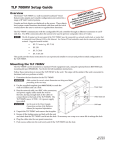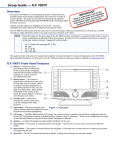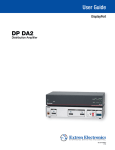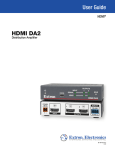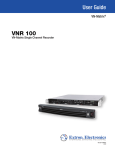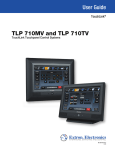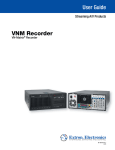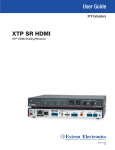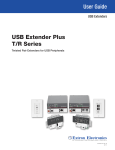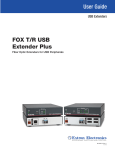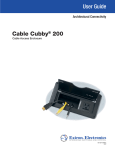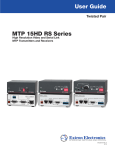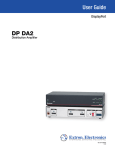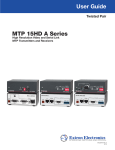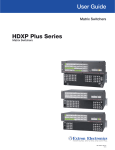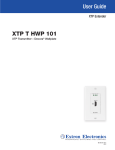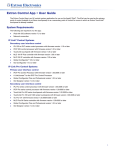Download TLP 700MV and TLP 700TV User Guide
Transcript
User Guide TouchLink® TLP 700MV and TLP 700TV TouchLink Touchpanel Control Systems 68-1378-01 Rev. C 01 15 Safety Instructions Safety Instructions • English WARNING: This symbol, D, when used on the product, is intended to alert the user of the presence of uninsulated dangerous voltage within the product’s enclosure that may present a risk of electric shock. ATTENTION: This symbol, I, when used on the product, is intended to alert the user of important operating and maintenance (servicing) instructions in the literature provided with the equipment. For information on safety guidelines, regulatory compliances, EMI/EMF compatibility, accessibility, and related topics, see the Extron Safety and Regulatory Compliance Guide, part number 68-290-01, on the Extron website, www.extron.com. Instructions de sécurité • Français AVERTISSEMENT : Ce pictogramme, D, lorsqu’il est utilisé sur le produit, signale à l’utilisateur la présence à l’intérieur du boîtier du produit d’une tension électrique dangereuse susceptible de provoquer un choc électrique. ATTENTION : Ce pictogramme, I, lorsqu’il est utilisé sur le produit, signale à l’utilisateur des instructions d’utilisation ou de maintenance importantes qui se trouvent dans la documentation fournie avec le matériel. Pour en savoir plus sur les règles de sécurité, la conformité à la réglementation, la compatibilité EMI/EMF, l’accessibilité, et autres sujets connexes, lisez les informations de sécurité et de conformité Extron, réf. 68-290-01, sur le site Extron, www.extron.com. Sicherheitsanweisungen • Deutsch WARNUNG: Dieses Symbol D auf dem Produkt soll den Benutzer darauf aufmerksam machen, dass im Inneren des Gehäuses dieses Produktes gefährliche Spannungen herrschen, die nicht isoliert sind und die einen elektrischen Schlag verursachen können. Инструкция по технике безопасности • Русский ПРЕДУПРЕЖДЕНИЕ: Данный символ, D, если указан на продукте, предупреждает пользователя о наличии неизолированного опасного напряжения внутри корпуса продукта, которое может привести к поражению электрическим током. ВНИМАНИЕ: Данный символ, I, если указан на продукте, предупреждает пользователя о наличии важных инструкций по эксплуатации и обслуживанию в руководстве, прилагаемом к данному оборудованию. Для получения информации о правилах техники безопасности, соблюдении нормативных требований, электромагнитной совместимости (ЭМП/ЭДС), возможности доступа и других вопросах см. руководство по безопасности и соблюдению нормативных требований Extron на сайте Extron: www.extron.com, номер по каталогу - 68-290-01. Chinese Simplified(简体中文) D产品上的这个标志意在警告用户该产品机壳内有暴露的危险 电压, 有触电危险。 警告: 注 意 :I 产 品 上 的 这 个 标 志 意 在 提 示 用 户 设 备 随 附 的 用 户 手 册 中 有 重要的操作和维护(维修)说明。 关于我们产品的安全指南、遵循的规范、EMI/EMF 的兼容性、无障碍 使用的特性等相关内容,敬请访问 Extron 网站 www.extron.com,参见 Extron 安全规范指南,产品编号 68-290-01。 Chinese Traditional(繁體中文) 警告: D 若產品上使用此符號,是為了提醒使用者,產品機殼內存在著 可能會導致觸電之風險的未絕緣危險電壓。 VORSICHT: Dieses Symbol I auf dem Produkt soll dem Benutzer in der im Lieferumfang enthaltenen Dokumentation besonders wichtige Hinweise zur Bedienung und Wartung (Instandhaltung) geben. Weitere Informationen über die Sicherheitsrichtlinien, Produkthandhabung, EMI/EMF-Kompatibilität, Zugänglichkeit und verwandte Themen finden Sie in den Extron-Richtlinien für Sicherheit und Handhabung (Artikelnummer 68‑290-01) auf der Extron-Website, www.extron.com. 注意I 若產品上使用此符號,是為了提醒使用者,設備隨附的用戶手冊中有重要 的操作和維護(維修)説明。 有關安全性指導方針、法規遵守、EMI/EMF 相容性、存取範圍和相關主題的詳細資訊, 請瀏覽 Extron 網站:www.extron.com,然後參閱《Extron 安全性與法規遵守手 冊》,準則編號 68-290-01。 Instrucciones de seguridad • Español ADVERTENCIA: Este símbolo, D, cuando se utiliza en el producto, avisa al usuario de la presencia de voltaje peligroso sin aislar dentro del producto, lo que puede representar un riesgo de descarga eléctrica. ATENCIÓN: Este símbolo, I, cuando se utiliza en el producto, avisa al usuario de la presencia de importantes instrucciones de uso y mantenimiento recogidas en la documentación proporcionada con el equipo. Para obtener información sobre directrices de seguridad, cumplimiento de normativas, compatibilidad electromagnética, accesibilidad y temas relacionados, consulte la Guía de cumplimiento de normativas y seguridad de Extron, referencia 68-290-01, en el sitio Web de Extron, www.extron.com. Japanese 警告: D この 記 号 が 製 品 上 に 表 示 さ れて い る 場 合 は 、筐 体 内 に 絶 縁 さ れて いない高電圧が流れ、感電の危険があることを示しています。 注意: I この記号 が製品上に表示されている場合は、本機の取扱説明書に記載されて いる重要な操作と保守(整備)の指示についてユーザーの注意を喚起するものです。 安全上のご注意、法令遵守、EMI/EMF適合性、その他の関連項目に ついては、エクストロンのウェブサイトwww.extron.comより 『Extron Safety and Regulatory Compliance Guide』 (P/N 68-290-01) をご覧く ださい。 Korean 경고: 이 기호 D, 가 제품에 사용될 경우, 제품의 인클로저 내에 있는 접지되지 않은 위험한 전류로 인해 사용자가 감전될 위험이 있음을 경고합니다. 주의: 이 기호 I, 가 제품에 사용될 경우, 장비와 함께 제공된 책자에 나와 있는 주요 운영 및 유지보수(정비) 지침을 경고합니다. 안전 가이드라인, 규제 준수, EMI/EMF 호환성, 접근성, 그리고 관련 항목에 대한 자세한 내용은 Extron 웹 사이트(www.extron.com)의 Extron 안전 및 규제 준수 안내서, 68-290-01 조항을 참조하십시오. FCC Class A Notice This equipment has been tested and found to comply with the limits for a Class A digital device, pursuant to part 15 of the FCC rules. The Class A limits provide reasonable protection against harmful interference when the equipment is operated in a commercial environment. This equipment generates, uses, and can radiate radio frequency energy and, if not installed and used in accordance with the instruction manual, may cause harmful interference to radio communications. Operation of this equipment in a residential area is likely to cause interference; the user must correct the interference at his own expense. NOTE: • This unit was tested with shielded I/O cables on the peripheral devices. Shielded cables must be used to ensure compliance with FCC emissions limits. • For more information on safety guidelines, regulatory compliances, EMI/EMF compatibility, accessibility, and related topics, see the Extron Safety and Regulatory Compliance Guide on the Extron website. Copyright © 2015 Extron Electronics. All rights reserved. Trademarks All trademarks mentioned in this guide are the properties of their respective owners. The following registered trademarks(®), registered service marks(SM), and trademarks(TM) are the property of RGB Systems, Inc. or Extron Electronics: Registered Trademarks (®) AVTrac, Cable Cubby, CrossPoint, eBUS, EDID Manager, EDID Minder, Extron, Flat Field, GlobalViewer, Hideaway, Inline, IP Intercom, IP Link, Key Minder, LockIt, MediaLink, PlenumVault, PoleVault, PowerCage, Pure3, Quantum, SoundField, SpeedMount, SpeedSwitch, System INTEGRATOR, TeamWork, TouchLink, V‑Lock, VersaTools, VN‑Matrix, VoiceLift, WallVault, WindoWall, XTP, XTP Systems Registered Service Mark(SM) : S3 Service Support Solutions Trademarks (™) AAP, AFL (Accu‑Rate Frame Lock), ADSP (Advanced Digital Sync Processing), Auto‑Image, CableCover, CDRS (Class D Ripple Suppression), DDSP (Digital Display Sync Processing), DMI (Dynamic Motion Interpolation), Driver Configurator, DSP Configurator, DSVP (Digital Sync Validation Processing), DTP, eLink, EQIP, FastBite, FlexOS, FOXBOX, Global Configurator, IP Intercom HelpDesk, LinkLicense, MAAP, MicroDigital, ProDSP, QS‑FPC (QuickSwitch Front Panel Controller), Scope‑Trigger, ShareLink, SIS (Simple Instruction Set), Skew‑Free, SpeedNav, Triple‑Action Switching, WebShare, XTRA, ZipCaddy, ZipClip Conventions Used in this Guide Notifications In this user guide, the following are used: WARNING: Potential risk of severe injury or death. AVERTISSEMENT : Risque potentiel de blessure grave ou de mort. CAUTION: Risk of minor personal injury. ATTENTION : Risque de blessure mineure. ATTENTION: • Risk of property damage. • Risque de dommages matériels. NOTE: A note draws attention to important information. Software Commands Commands are written in the fonts shown here: ^AR Merge Scene,,Op1 scene 1,1 ^B 51 ^W^C [01] R 0004 00300 00400 00800 00600 [02] 35 [17] [03] E X!*X1&*X2)*X2#*X2! CE} NOTE: For commands and examples of computer or device responses mentioned in this guide, the character “0” is used for the number zero and “O” represents the capital letter “o”. Computer responses and directory paths that do not have variables are written in the font shown here: Reply from 208.132.180.48: bytes=32 times=2ms TTL=32 C:\Program Files\Extron Variables are written in slanted form as shown here: ping xxx.xxx.xxx.xxx —t SOH R Data STX Command ETB ETX Selectable items, such as menu names, menu options, buttons, tabs, and field names are written in the font shown here: From the File menu, select New. Click the OK button. Specifications Availability Product specifications are available on the Extron website, www.extron.com. Contents Introduction............................................................ 1 Configuration Software...................................... 16 About the TLP 700MV and TLP 700TV................ 1 Features.............................................................. 2 Requirements...................................................... 3 Software.......................................................... 3 Hardware......................................................... 3 Software Overview............................................. 16 Installing the Software........................................ 17 Installation from the Extron Web Site.............. 17 Updating the Firmware...................................... 18 Updating Firmware Using the Extron Firmware Loader Utility...................... 18 Updating Firmware From a Web Browser GUI...................................... 19 Using the TouchLink Panel Web Pages.............. 20 Using GUI Configurator...................................... 22 Using Global Configurator.................................. 26 Panel Features....................................................... 4 TLP 700MV Front Panel Features and Operations................................................... 4 TLP 700MV Rear Panel Features and Connections................................................ 5 TLP 700TV Front Panel Features and Operations................................................... 8 TLP 700TV Rear Panel Features and Connections................................................ 9 With Stand Attached....................................... 9 TLP 700TV Base Features................................. 10 On-screen Menus................................................ 12 How to Access the Internal On-screen Menus... 12 Main Screen...................................................... 12 Volume Screen.................................................. 13 Time Screen...................................................... 14 Network Screen................................................. 14 Video Screen..................................................... 15 Touch Calibration Screen................................... 15 Mounting................................................................ 32 Rack Mounting the TLP 700MV......................... 32 Underwriters Laboratories Guidelines for Rack Mounting........................................ 32 Rack Mounting the TLP 700MV..................... 32 Wall Mounting the TLP 700MV.......................... 33 Wall Mounting the TLP 700MV with a Wall Box........................................................ 34 Desktop Mounting the TLP 700TV..................... 35 Removing the TLP 700TV Base for VESA Mounting................................................ 35 VESA Mounting the TLP 700TV......................... 40 Reset Modes......................................................... 41 Button Labels....................................................... 42 Button Label Software....................................... 42 Installing or Replacing Button Labels............. 42 Button Label Generator Software................... 42 Installing the Button-Label Generator Software....................................................... 42 Using the Button-Label Generator Software....................................................... 43 Replacing Button Labels.................................... 44 TLP 700MV and TLP 700TV • Contents v TLP 700MV and TLP 700TV • Contents vi Introduction This guide describes the function, installation and operation of the TouchLink TLP 700MV and TLP 700TV Touchpanels. Unless otherwise stated, the terms “TLP 700 series,” “TLP 700,” “touchpanel,” and “TouchLink touchpanel” refer to both models. The guide also provides information about optional accessories that are available from Extron for both panels. This section provides the following information: • About the TLP 700MV and TLP 700TV • Features • Requirements About the TLP 700MV and TLP 700TV Both models have 7-inch LCD screens with a resolution 800x480. The screen displays graphic objects and text, which are associated with user-defined functions. The touch overlay allows the user to initiate or activate functions by touching the objects on the screen. The Extron TLP 700MV is a wall mounted TouchLink panel. The TLP 700TV comes with a stand that allows it to be placed on a desktop. If the stand is removed, the unit can be VESA® mounted on a wall or furniture, using the optional Extron kits. Both units have ten push buttons (five along each side of the screen) and an encoder knob. These allow common, user-defined functions to be activated and calibrated independently of the screen. The units can be customized by using a bezel kit to cover the buttons, the encoder knob, or both. A motion sensor, light sensor, and a speaker provide auto dimming, sleep mode, and audible feedback. Extron GUI Configurator software allows the user to design the screen layout by selecting from existing templates or designing entirely new interfaces on their PC and uploading the completed project to the TouchLink panel. The user can define the graphics and the functions associated with those graphics, providing versatility and adaptability to the configuration and control of an AV system. TLP 700MV and TLP 700TV • Introduction 1 TCP/IP Network VC R DVD C DO M CA LA PT OP PC ON OFF Contact Closure Extron IN1508 RE 1 Motion Detector IR 2 M CO RX TX N LA B RS- INP UT 4 8 G RE 3 LAY4 S G S IP Link-Ethernet Control Interface G Extron TLP 700MV 7" TouchLink Panel RS-232 L R 7 AU 2 1 UT L RGB , R-Y B-Y R TP OU D LISTE 1T23 U S I.T.E. C Y, 6 8 DVI RGB R-Y B-Y I Hz 50-60 40V 100-2 N U T 5 Y VID P Extron XPA 1002 Power Amplifier 7 RGB 3 YC 1 VID 4 2 XPA 1002 Extron SI 28 ron EN RE SC WN DO 232 R 6 5 DIO3 S IR 4 Ext EN RE SC UP 3 3 UT INP 4 3 2 A L G S RX Extron IPL 250 R WE PO 12VmA 500X MA RS-232 UT TP OU 1 1 2 M1 SC TS CO RT TX M CO RX TX Scaling Presentation Switcher LAY2 Y LA E DISP MUT Lighting System IR Control to DVD Surface-mount Speakers CT 1 OVER TEMP 2 /PROTE LIMITER SIGNAL RS-232 DVD Player Extron IR Emitter Relay Laptop IR Control from IPL 250 Projector Screen Control PC DVI Output Figure 1. TLP 700MV Application Diagram Features 7-inch LCD screen — displays a range of graphic objects and text on an 800 x 480 pixel screen. Touch screen overlay — provides simple and intuitive control over a range of functions by touching the icons displayed on the screen. Video preview — allows composite or S-video previews. GUI Configurator and Global Configurator Software — allows the user to design a custom graphical user interface and associate a range of different functions with objects in that display. No programming knowledge is needed. Easy configuration and flexibility — on-screen graphics and text, as well as the functions associated with them, can be easily changed to adapt the control panel to the evolving needs of the system, avoiding the need for additional control modules. Ten buttons — for common, user-defined functions. Ethernet connection — provides an inexpensive, easily installed, cabling option for connecting products located anywhere else on the network. Compatible with most Extron IP Link products — allows easy integration into existing systems. NOTE: These products are not compatible with the Extron Pro series of devices. Front panel encoder knob — primarily for volume control, but can be configured for other functions. Light sensor — adjusts LCD screen backlighting to compensate for ambient lighting. Motion sensor — When no motion is detected for a user-defined period of time, the unit enters sleep mode to conserve power. When a user approaches the screen, the panel detects motion and is reactivated. TLP 700MV and TLP 700TV • Introduction 2 Loudspeaker — provides audible feedback in response to events triggered by the user. Multiple mounting options — The TLP 700MV can be wall-mounted, rack-mounted, or furniture‑mounted. The TLP 700TV comes with a stand that allows it to be placed on a desktop. If the stand is removed, the unit can be VESA‑mounted on a wall or furniture using either of the optional Extron kits. Color Options for TLP 700MV — The TLP 700MV is available in different color versions. Customization kits — A range of kits are available to customize the TouchLink panel. Requirements Software For a complete list of the requirements for running Global Configurator 3 or GUI Configurator, see www.extron.com for that software. NOTE: These touchpanels and controllers are not compatible with GUI Designer or Global Configurator Plus and Global Configurator Professional. Hardware An Extron IP Link control interface must also be connected to the same network domain as the TouchLink panel. See www.extron.com for a list of suitable controllers. NOTE: These touchpanels and controllers are not compatible with the Extron Pro series of devices. TLP 700MV and TLP 700TV • Introduction 3 Panel Features This section describes: TLP 700MV Front Panel Features and Operations TLP 700MV Rear Panel Features and Connections TLP 700TV Front Panel Features and Operations TLP 700TV Rear Panel Features and Connections TLP 700TV Base Features TLP 700MV Front Panel Features and Operations Figure 2. TLP 700MV Front Panel A Buttons — These ten backlit push-buttons (five on either side of the screen) can be configured to execute user-defined functions using the Extron Global Configurator software (page 26). For information about creating button labels, see page 43. B Motion Sensor — is capped with a small Fresnel lens that focuses light onto the sensor. When no motion has been detected for a user-defined period of time, the unit goes into sleep mode. When motion is detected in the vicinity of the panel, the screen display is restored and all buttons are active. C Encoder Knob — controls the volume or it can be configured for other functions. D Light Sensor — monitors the level of ambient light and adjusts the screen brightness and button backlighting. E LCD screen — has an 800 x 480 resolution with a touch overlay. A graphic user interface is designed using the Extron GUI Configurator software to display buttons, text, or icons on the screen (page 22). These can be configured for a range of userdefined functions, using the Extron Global Configurator software (page 26). F Speaker — A single 2 watt speaker provides audible feedback for the user. TLP 700MV and TLP 700TV • Panel Features 4 There are three buttons and an LED recessed behind the bezel. These buttons are used to configure the unit and reset parameters to factory defaults: A B C Figure 3. TLP 700MV Front Panel with Bezel removed A Reset button — allows the unit to be reset in any of four different modes (see Reset Modes on page 41). B Menu button — activates the on-screen menus for setting up and calibrating the unit (see page 12). C Reset LED — is visible only when the bezel has been removed. It lights as an indicator for the Reset modes (see Reset Modes on page 41). TLP 700MV Rear Panel Features and Connections A B C Power Connector Video Input Network Connector Figure 4. TLP 700MV Rear Panel Features TLP 700MV and TLP 700TV • Panel Features 5 A Power Connector (see figure 4 on the previous page) — Connect the two pole, 3.5 mm captive screw connector from the provided power supply to the power supply socket on the rear panel. Ensure the connections have the correct polarity as shown below: POWER 12V 1.0 A MAX Power Receptacle Smooth POWER 12V 0.4A MAX Ridges A A SECTION A–A DC Power Cord Captive Screw Connector Power Supply Output Cord 3/16" (5 mm) Max. Ground +12 VDC AC Power Cord Figure 5. External Power Supply (12 VDC, 1 A ) Power Supply Connection WARNING: The two power cord wires must be kept separate while the power supply is plugged in. Remove power before wiring. AVERTISSEMENT : Les deux cordons d’alimentation doivent être tenus à l’écart l’un de l’autre quand l’alimentation est branchée. Couper l’alimentation avant de faire l’installation électrique. CAUTION: Risk of Explosion. Do not replace the battery with an incorrect type. Dispose of used batteries according to the instructions of the manufacturer. ATTENTION : Risque d’explosion. Ne pas remplacer la pile par le mauvais type de pile. Débarrassez-vous des piles utilisées selon les instructions du fabricant. TLP 700MV and TLP 700TV • Panel Features 6 ATTENTION: • Always use a power supply supplied by or specified by Extron. This product is intended for use with a UL Listed power source marked “Class 2” or “LPS” and rated 12VDC, minimum 1.0 A. Use of an unauthorized power supply voids all regulatory compliance certification and may cause damage to the supply and the end product. • Utilisez toujours une source d’alimentation fournie ou recommandée par Extron. Ce produit est destiné à une utilisation avec une source d’alimentation listée UL avec l’appellation « Classe 2 » ou « LPS » et normée 12 Vcc, 1,0 A minimum. L’utilisation d’une source d’alimentation non autorisée annule toute conformité réglementaire et peut endommager la source d’alimentation ainsi que le produit final. • Extron power supplies are certified to UL/CSA 60950-1 and are classified as LPS (Limited Power Source). Use of a non-LPS or unlisted power supply will void all regulatory compliance certification. • Les sources d’alimentation Extron sont qualifiées UL/CSA 60950-1 et sont classées LPS (Limited Power Source). L’utilisation d’une source d’alimentation nonlistée ou non-listée LPS annulera toute certification de conformité réglementaire. • The power supply shall not be permanently fixed to the building structure or similar structures. • La source d’alimentation ne devra pas être fixée de façon permanente à une structure de bâtiment ou à une structure similaire. • This power supply is not suitable for use in air handling spaces or in wall cavities. The power supply is to be located within the vicinity of the Extron AV equipment in an ordinary location with IEC 1010 pollution degree 2, and secured to an equipment rack within a dedicated closet, podium, or desk. • Cette source d’alimentation n’est pas appropriées pour une utilisation dans les espaces d’aération ou dans les cavités murales. Cette source d’alimentation doit être située à proximité de l’équipement audiovisuel d’Extron, dans un endroit ordinaire avec une pollution IEC 1010 degré 2, et fixé à un équipement de rack au sein d’un placard, d’une estrade ou d’un bureau qui lui est dédié. • The installation shall be in accordance with the applicable provisions of National Electrical Code ANSI/NFPA 70, article 725 and the Canadian Electrical Code part 1, section 16. • Cette installation doit toujours être en accord avec les mesures qui s’applique au National Electrical Code ANSI/NFPA 70, article 725, et au Canadian Electrical Code, partie 1, section 16. • The length of the exposed wires in the stripping process is critical. The ideal length is 3/16 inches (5 mm). If they are longer, the exposed wires may touch, causing a short circuit between them. If they are shorter, the wires can be easily pulled out even if tightly fastened by the captive screws. • La longueur des câbles exposés est primordiale lorsque l’on entreprend de les dénuder. La longueur idéale est de 5 mm (3/16 inches). S’ils sont un peu plus longs, les câbles exposés pourraient se toucher et provoquer un court circuit. S’ils sont un peu plus courts, ils pourraient sortir, même s’ils sont attachés par les vis captives. • Do not tin the wire leads before installing into the connector. Tinned wires are not as secure in the connector and could be pulled out. • Ne pas étamer les conducteurs avant de les insérer dans le connecteur. Les câbles étamés ne sont pas aussi bien fixés dans le connecteur et pourraient être retirés. TLP 700MV and TLP 700TV • Panel Features 7 B Video Input (see figure 4 on page 5) — Connect an S-video or composite video source to the unit, using these two BNC connectors: For S-video, connect the Y (luminance) signal to the VID/Y input and the C (chrominance) signal to the C input. For composite video, connect the input to the VID/Y input. C Network Connector (see figure 4) — The TLP 700MV connects to an Ethernet LAN using a twisted pair cable, terminated with an RJ45 connector (see the figure at right). Use a straight-through Ethernet cable to connect the panel to a switch or router. Use a crossover cable to connect the panel directly to a computer. Plug one end of the cable into the RJ-45 socket and the other end into a network switch, hub, or router that is connected to an Ethernet LAN or the Internet. An Extron IP Link control interface must also be connected to the same network domain. The LAN Port connector (see the figure to the right) has two LED lights. The Link LED lights green to indicate a good network connection. The Activity LED blinks yellow when network activity occurs. TLP 700TV Front Panel Features and Operations Link LED LAN LAN Port Activity LED RJ-45 Port Figure 6. TLP 700TV Front Panel Features A B C D E Buttons Motion sensor Encoder knob Light sensor F G H I Speaker Reset button Menu button Reset LED LCD screen TLP 700MV and TLP 700TV • Panel Features 8 A Buttons (see figure 6 on the previous page) — These ten backlit push-buttons (five on either side of the screen) can be configured to execute user-defined functions using the Extron Global Configurator software (page 26). For information about creating button labels, see page 43. B Motion Sensor (see figure 6) — is capped with a small Fresnel lens that focuses light onto the sensor. When no motion has been detected for a user-defined period of time, the unit goes into sleep mode. When motion is detected in the vicinity of the panel, the sleep mode is overridden and the screen display is restored. C Encoder Knob (see figure 6) — controls the volume but it can be configured for other functions. D Light Sensor (see figure 6) — monitors the level of ambient light and adjusts the screen brightness and button backlighting. E LCD screen (see figure 6) — has an 800 x 480 resolution with a touch overlay. A graphic user interface is designed using the Extron GUI Configurator software (page 22) to display buttons, text, or icons on the screen. These can be configured for a range of user-defined functions, using the Extron Global Configurator software (page 26). F Speaker (see figure 6) — A single 2 watt speaker provides audible feedback for the user. G Reset button (see figure 6) — recessed behind the bezel. It allows the unit to be reset in any of four different modes. For further information see Reset Modes on page 41. H Menu button (see figure 6) — recessed behind the bezel. It activates the on-screen menus for setting up and calibrating the unit (see page 12). I Reset LED (see figure 6) — recessed behind the bezel. It lights as an indicator for the Reset modes. For further information see Reset Modes on page 41. TLP 700TV Rear Panel Features and Connections With Stand Attached A B C D LED lights Network connector Power connector MTP connector Figure 7. TLP 700TV Rear Features TLP 700MV and TLP 700TV • Panel Features 9 The following connections are available through the back panel when the stand is in place: A LED lights (see figure 7 on the previous page) —The Link LED lights green to indicate a good network connection. The Activity LED blinks yellow when network activity occurs. B Network connector (see figure 7) — Use straight-through twisted pair cable to connect the TLP 700TV to a network switch or router. Use a crossover cable to connect the panel directly to a PC. An Extron IP Link control interface must be connected to the same network domain. C Power connector (see figure 7) — Connect the provided power supply to this 2-pole captive screw connector. See the Attention on page 7 for important information about the power supply. D MTP connector (see figure 7) — Twisted pair input with RJ-45 connector provides video and audio input. ATTENTION: • The left RJ-45 connector on the back of the TLP 1000TV (with the yellow and green LEDs) must be connected to a network. The right RJ-45 connector must be connected to an Extron MTP Transmitter. The MTP and LAN use different voltages; switching the connectors will damage the touchpanel. • Le connecteur RJ-45 gauche situé au dos du TLP 1000MV (avec des LED jaunes et vertes) doit être connecté à un réseau. Le connecteur RJ-45 droit doit être connecté à un émetteur MTP Extron. Le MTP et le LAN utilisent des tensions différentes; permuter les connections risque d’endommager l’écran tactile. NOTE: Audio input is available only from an Extron MTP transmitter through the RJ-45 connector in the base of the unit. If the base is removed from the TLP 700TV, connections are via BNC connectors and there is no audio input. TLP 700TV Base Features Figure 8. TLP 700TV Base Features A B Adjustable potentiometers C Security mounting holes Access for disconnecting RJ‑45 connectors TLP 700MV and TLP 700TV • Panel Features 10 The TLP 700TV stand, which can be removed for VESA mounting, has: A Three adjustable potentiometers (see figure 8 on the previous page) — These are used to control sharpness and gain for both S-video luminance (Y) and S-video chrominance (C). If a composite video signal is used, the gain is controlled by the center potentiometer (Vid/Y). C Gain Vid/Y Gain Sharp 33-1814-01 A Figure 9. TLP 700TV Potentiometers B Access for disconnecting RJ-45 connectors (see figure 8) — When RJ-45 connectors are covered with a protective boot, it can be difficult to remove them from their sockets. The two holes are directly underneath the two RJ-45 jacks (see figure 7 on page 9). Push the tip of a pen or pencil through the holes to help disconnect the RJ‑45 connectors. C Security mounting holes (see figure 8) — If required, secure the unit to the desktop, using two screws (see page 35). TLP 700MV and TLP 700TV • Panel Features 11 On-screen Menus This section describes: • How to Access the Internal On-screen Menus • Main Screen • Volume Screen • Time Screen • Network Screen • Video Screen • Touch Calibration Screen How to Access the Internal On-screen Menus When power is first applied to the TouchLink Panel, the unit boots up and displays the opening screen. To access the on-screen menus, press the Menu button, located below the screen (see figure 3, on page 5 for the TLP 700MV or figure 6, on page 8 for the TLP 700TV). The menus open at the Main screen. There are five screens (Main, Volume, Time, Network, and Video) that can be selected by pressing the appropriate button at the left side of the screen. There is also an Exit button at the bottom left corner of the screen for leaving the menus. Main Screen Figure 10.Main Screen Sleep timer determines how long the panel is inactive before it enters Sleep mode, when the screen goes dark to save power. Press the Down or Up buttons to highlight the Sleep timer options and continue to use the buttons or use the front panel volume control knob to adjust the time from 0 to 50,000 seconds (in 10-second increments). The time that is currently selected is shown above the buttons. TLP 700MV and TLP 700TV • On-screen Menus 12 The screen may need a high level of backlighting to read the screen when ambient lighting is high. With low ambient lighting, the backlighting should also be low. Auto Backlight provides a suitable amount of backlighting that is automatically calculated from the amount of ambient light detected by the light detector. When Auto Backlight is set to Off, the Backlight option allows the backlighting to be set manually from 0 to 100%. Press the Down or Up buttons to highlight the Backlight options and use the volume control knob or press the Down or Up buttons to adjust the backlighting. The current value is shown above the buttons. NOTE:When Auto Backlight is set to On, changing the percentage of Backlight does not affect the amount of backlighting. LED Backlight lights the ten buttons next to the screen. Wake on Motion activates the panel from Sleep mode when motion is detected near the unit. Use the on-screen buttons to toggle the Auto Backlight, LED Backlight, or Wake on Motion options between Off and On. Volume Screen Figure 11.Volume Screen Click on the Down or Up buttons to highlight one of the adjustable audio features. Use the Down and Up buttons or the volume control knob to adjust: Master volume (between 0 and 255) sets the maximum volume for all the other sound volume settings. For example, if the master volume is set to 200 (approximately 80% of maximum), even when the Line In volume is set to 255 (maximum), it is only equivalent to 80% of maximum. Click (between 0 and 255) sets the volume for audible feedback that accompanies events such as a side button or screen button being pressed. Sounds (between 0 and 255) sets the volume of audio from an audio file playback. Line In (between 0 and 255) sets the volume of the audio signal received through the line in from and Extron MTP transmitter. TLP 700MV and TLP 700TV • On-screen Menus 13 Time Screen Figure 12.Time Screen Click on the Down or Up buttons to highlight one of the adjustable time settings. Use the buttons or the volume control knob to adjust the Month, Day, Year, Hours, and Minutes. NOTE:The Hours value uses the 24 hour clock. For 10 am, set Hours to 10; for 10 pm, set Hours to 22. Network Screen Figure 13.Network Screen Set the IP Address or Subnet Mask by pressing the appropriate button. An on‑screen keypad appears that allows you to enter digits from 0 through 9 or “.” (dot). In the event of an error, you can clear the field. NOTE: The factory default IP address for the TLP 700MV is 192.168.254.254. The default subnet mask is 255.255.0.0. Consult with your IT Department to ensure these addresses are correctly assigned. Toggle between On and Off to enable or disable Dynamic Host Configuration Protocol (DHCP). This determines whether the unit has a permanent IP address or has one provided by the network, when required. The default setting is off. TLP 700MV and TLP 700TV • On-screen Menus 14 Video Screen Figure 14.Video Screen The small gray rectangle provides a video preview window that allows the user to adjust the video properties. Click on the Down or Up buttons to highlight one of the adjustable video settings. Use the Down and Up buttons or the volume control knob to adjust: • Contrast between 0 and 127 (default, 64) • Color between 0 and 127 (default, 64) • Brightness between 0 and 255 (default, 128) • Tint between 0 and 255 (default, 128) Touch Calibration Screen After setting the values, press the Menu button a second time to calibrate the touch area of the Touchpanel. Press on the green box until the color reverts to gray with a white border and a second box is highlighted. Repeat until all four boxes have been pressed and calibrated. At that point the screen returns to the Main screen (see page 12). To exit from the on-screen menus, press the Exit button in the bottom left corner of the menu screens. TLP 700MV and TLP 700TV • On-screen Menus 15 Configuration Software This section of the guide discusses the software and firmware needed to set up the Touchpanel units: • Software Overview • Installing the Software • Updating the Firmware • Using the TouchLink Panel Web Pages • Using GUI Configurator • Using Global Configurator Software Overview Designing a graphical user interface (GUI) for the TouchLink Panel takes two steps: • Design the layout of the text and graphics using GUI Configurator (see page 22). • Assign functions to the text and graphics using Global Configurator (see page 27). The touchpanel screen is designed using GUI Configurator either by customizing an existing template or by designing an entirely new interface. GUI Configurator offers several templates that are designed to manage control system devices. After the GUI has been designed on a PC, the project is saved, built, and uploaded to the TLP unit to verify what it looks like on the screen. It is then imported from the TLP unit to Global Configurator where control functions are assigned to the text and graphic items in the layout. After assigning the control functions, the project is rebuilt and uploaded to the IP Link control interface. These two programs provide versatility and adaptability for configuration and control of an AV system as it grows and evolves. TLP 700MV and TLP 700TV • Configuration Software 16 Installing the Software Installation from the Extron Web Site Both programs can be downloaded from the Extron Web site (www.extron.com). 1. Select the Download tab (figure 15, 1). 2. Click on the Software option in the sidebar at the left (2). Figure 15. Extron Website — Software Download Center 3. Click on the letter “G” to navigate to GUI Configurator or Global Configurator (3). NOTE: These touchpanels and controllers are not compatible with GUI Designer or Global Configurator Plus and Global Configurator Professional. 4. Click Download next to the program. 5. Follow the on‑screen instructions to complete installation. A folder is created on the C‑drive and an icon may be placed on the desktop. TLP 700MV and TLP 700TV • Configuration Software 17 Updating the Firmware Firmware for the TLP 700 can be upgraded using the Extron Firmware Loader (see below) or using your Web browser GUI (see page 19). Before starting, consult your IT team and ensure that the TLP 700 has a unique IP address. Updating Firmware Using the Extron Firmware Loader Utility NOTES: • To use this method, you must have Extron Firmware Loader installed on your PC. The program can be downloaded and installed, free of charge, from the Extron Web site. Follow the directions given on page 17 for downloading and installing GUI Configurator and Global Configurator. • Your PC must have internet access and be on the same network as the TouchLink Panel. 1. On the Extron Web site, select the Download tab (see figure 15 on the previous page) 2. Click on the Firmware option in the menu bar at the left of the screen. 3. Navigate to the TLP 700 firmware and click Download. The TLP 700 firmware is compatible with both the TLP 700MV and TLP 700TV. The firmware downloads to your computer. NOTE: Make a note of the folder in which the firmware file is saved. Open the Extron Firmware Loader. The Add Device... dialog box opens. Select TLP 700MV or TLP 700TV from the device list. Select TCP/IP as the connection method. Enter the IP address for the TLP 700, a Telnet port number, and, if necessary, the administrator password. Click OK. The device name appears in the connected device box with a green check mark. 8. Use the Browse button to locate the firmware file that you downloaded in step 3. 9. Click Add. The main Firmware Loader window comes into focus with the TLP 700 in the device list. 10.Highlight the TLP 700 and click Begin. The firmware transfer begins and the progress is shown by a green bar in the Total Progress panel. 11.When “Total Progress” shows 100% and Completed, exit the Firmware Loader. 12.When the firmware is installed, calibrate the panel, using the on-screen menus (see page 12) or the TouchLink panel Web pages (see page 20). 4. 5. 6. 7. TLP 700MV and TLP 700TV • Configuration Software 18 Updating Firmware From a Web Browser GUI NOTE: Your PC must have internet access and be on the same network as the TouchLink Panel. 1. On the Extron Web site, select the Download tab 2. Click on the Firmware option in the menu bar at the left of the screen (see figure 15 on page 17). 3. Navigate to the TLP 700 firmware and click Download. The firmware downloads to your computer. NOTE: Make a note of the folder in which the firmware file is saved. 4. Open your browser and type the IP address of the TLP 700 unit into the address box (figure 16, 1). The browser opens the TouchLink Touchpanel Web pages. 5. Click on the Configuration tab at the top of the page (2). Select Firmware Upgrade from the bar on the left (3). If prompted, enter the administrator password. Figure 16. Firmware Upgrade Web Page 6. Use the Browse button (4) to navigate to the firmware file (see step 3). 7. Click Upload (5). The Touchpanel screen shows the message “Firmware Uploading... Please Wait...”. The TouchLink Panel restarts after the firmware is loaded. 8. When the firmware is installed, calibrate the panel, using the on-screen menus (see page 12) or the TouchLink panel Web pages (see page 20). TLP 700MV and TLP 700TV • Configuration Software 19 Using the TouchLink Panel Web Pages As seen in the previous section, the TLP 700MV and TLP 700TV TouchLink Panels have default Web pages that can be used to read and change the current settings of the panels. The Web pages can be accessed as follows: 1. Open your browser and enter the IP address of the TLP 700 unit into the address box. The browser opens the TouchLink Panel Status page, which is read-only and provides basic information about the model, date and time, and IP settings. Figure 17. TLP 700 Status Tab 2. Click the Configuration tab (figure 18, 1) and click the System Settings link (2). This page allows the user to modify information about the IP settings and the date and time settings. These correspond to the Network settings (see page 14) and Time settings (see page 14) in the on-screen menus. Figure 18. TLP 700 Configuration Tab: System Settings Page TLP 700MV and TLP 700TV • Configuration Software 20 3. Click the Passwords link. This page allows the user to set Administrator and User passwords. To set a password, follow the instructions at the top of the page. Figure 19. TLP 700 Configuration Tab: Passwords Page 4. To upgrade the unit firmware, select Firmware Upgrade and follow the instructions on page 19. 5. Click the Touchpanel tab, which allows the user to alter the TouchLink panel and volume settings. These correspond to the Main settings (see page 12) and Volume settings (see page 13) in the on-screen menus. Figure 20. TLP 700 Touchpanel Tab: Configuration Page TLP 700MV and TLP 700TV • Configuration Software 21 Using GUI Configurator This section provides an overview of the GUI Configurator program. For complete information about the program, consult the GUI Configurator help file (click on Contents in the Help menu or press the <F1> key while within the program). To use the GUI Configurator program, follow these instructions: 1. Click the desktop icon. The program opens at the main screen with the GUI Configurator Start Options dialog box in front. Figure 21. GUI Configurator: Main and GUI Configurator Start Options Screens Figure 22. GUI Configurator Start Options Dialog Box TLP 700MV and TLP 700TV • Configuration Software 22 2. You can choose to: • Start a New Project — Select the Start a New Project radio button, then click OK. The New Project dialog box opens: Figure 23.GUI Configurator New Project Dialog Box • A series of icons offer you the choice of creating a project with a template or without a template and allow you to select the size and type of Touchlink Panel. If you are creating a project from an existing template, you can use the factory‑loaded templates or you can select a template that you have previously created. Open an Existing Project — Clicking OK opens a dialog box that allows you to navigate to an existing project for modification. Figure 24.GUI Configurator Dialog Box to Open an Existing Project Navigate to the existing file and select it. A preview with information about the file appears in the panel on the right. If you are working on the project, leave the Open as read-only box unchecked. Click Open to open the file. The project opens in GUI Configurator. TLP 700MV and TLP 700TV • Configuration Software 23 • Download an Existing Project from a Panel — Clicking OK opens a dialog box that allows you to download a file that has been uploaded to a panel. Figure 25.GUI Configurator Download Project Dialog Box In the dialog box that opens, enter the IP address of the panel and use the Browse button to navigate to a folder where the file will be saved. Check Open the project and Close Download Manager. Click OK. The project is downloaded to your computer and opens in GUI Configurator. TLP 700MV and TLP 700TV • Configuration Software 24 3. Depending on which option was selected in step 2, GUI Configurator opens to a new or an existing project. The initial screen is divided into a series of panels offering a range of tools that are used to design or modify the project. For full details on how to use the tools, consult the help file (in the Help menu click on Contents or press the <F1> key while within the program). Figure 26. GUI Configurator Main Screen 4. To save the project, select Save Project from the File menu. The project file is saved. If this is the first time saving the project file, the Save As dialog box opens. If the Save As dialog box appears: a. Browse for the location where the project file is to be saved. b. Enter a file name for the project. c. Click Save. 5. The project can be uploaded to one or more TouchLink Panels. To add a panel, to which the project can be uploaded: a. From the Project menu, select Add > Panel: Figure 27.Add a TouchLink panel (a) TLP 700MV and TLP 700TV • Configuration Software 25 The Panel Manager dialog box opens: Figure 28.Add a TouchLink panel (b) b. Click on the Add Panel icon to add a new panel to the list in the left pane. c. Highlight the name of the panel in the left pane to display the properties of that panel in the right pane. d. When a new panel is added, it has the default IP address (192.168.254.254). To change the IP address, highlight the address property and type in the correct IP address. Update any other properties, as required. e. Repeat steps 5a through 5d to add further panels, if required. 6. To upload a project to a TouchLink panel: a. From the Project menu, select Upload to Selected Panels. The Build Manager dialog box opens, showing the build progress. Once the build is complete, this dialog box closes and the File Upload Manager screen opens. The upload begins automatically. b. Select Close this dialog when upload completes checkbox in the Automatic Settings section so that the File Upload Manager screen closes automatically once the upload completes. This option can be set before or during the upload. If this project has been uploaded to the TouchLink Panel before, you can choose to upload the changes that have been made to the previous upload. You can also choose to upload to certain TouchPanels from the list of TouchLink Panels found within the Devices section of the File Upload Manager screen during the upload process. TLP 700MV and TLP 700TV • Configuration Software 26 Using Global Configurator NOTE: To configure a TouchLink Panel, you must use Global Configurator version 3.0 or later. This section provides an overview of the Global Configurator program. For complete information about the program, consult the Global Configurator help file (click Contents in the Help menu or press the <F1> key while within the program). These instructions describe how to set up a Global Configurator project with an IPL 250. Setting up a project with another IP Link product is similar but you should consult the Global Configurator help file for exact information about the product you are using. 1. Click on the GC3 desktop icon. The Global Configurator 3 Start Options box opens. Figure 29. Global Configurator 3 Start Options TLP 700MV and TLP 700TV • Configuration Software 27 2. Select Create A New Project and click OK. The dialog box closes, leaving the Project Settings screen. Figure 30. Global Configurator Project Settings 3. Enter the IP Address for the TLP 700MV panel. The default value for Telnet port is 23 and HTTP port is 80. These values do not usually need to be changed. 4. If necessary, set administrator and user passwords. 5. If required, set the date and time. 6. Leave the Set Device as GlobalViewer Host box checked. TLP 700MV and TLP 700TV • Configuration Software 28 7. Click OK and the Project Settings screen closes and is replaced by the Add Device dialog box: Figure 31. Global Configurator Add Device Dialog Box 8. To see all the options, click on the Advanced >>> button. The button name changes to Basic <<< (see figure 31, 1). 9. Select the IP Link device from the drop-down list (2). In figure 31, above, an IPL 250 controller is added. Adding a different IP Link product is similar. 10.Enter the IP address of the IP Link controller (3). The default value is 192.168.254.254, but this may have been changed. Check with your IT Department to verify the address. 11.Enter a Display Name into the text box (4). This is what the device will be known as in the Global Configurator project. 12.(Optional) Check the Make this device a GlobalViewer Host checkbox (5). 13.Set the Telnet Port (usually 23; 6) and the Web Port (usually 80; 7). 14.If the controller is password protected, enter the password now (8). 15.In the right panel, set up a GlobalViewer tree (9). For information about this, refer to the Global Configurator help file. TLP 700MV and TLP 700TV • Configuration Software 29 16.Click OK (¢) and the Add Device screen closes. The start-up screen, which was behind it, is now visible. The device configuration tree, in the panel to the left of the main screen, shows the IPL 250 and the available ports: Figure 32. Configuring an IP Link Device 17.Select Touchpanel Port 1 (figure 33,1). The screen shows the available options for the TouchLink Panel. To add the GUI Configurator project that was uploaded to the TouchLink Panel, click Click here to add one (2). Figure 33. Adding a TouchLink panel TLP 700MV and TLP 700TV • Configuration Software 30 18.The Add TouchPanel dialog box opens. Figure 34. Add Touchpanel Dialog Box. a. Select the correct model from the drop-down list (figure 34,1). b. Enter the IP address for the TouchLink Panel (2). c. Set the Telnet Port, usually 23, (3) and, if necessary, enter the password (4). d. Select the Import/Apply Layout check box (5). Click OK (6). 19.The window now shows the GUI from the TouchLink Panel. Figure 35. GUI from TouchLink Panel added to Global Configurator. For complete instructions on how to assign functions to the buttons on the screen, see the Global Configurator help file, which is opened by clicking on Contents in the Help menu, or by pressing the <F1> key while within the program. TLP 700MV and TLP 700TV • Configuration Software 31 Mounting This section outlines the various options for: • Rack Mounting the TLP 700MV • Wall Mounting the TLP 700MV • Wall Mounting the TLP 700MV with a Wallbox • Desktop Mounting the TLP 700TV • Removing the TLP 700TV base for VESA Mounting • VESA mounting the TLP 700TV Rack Mounting the TLP 700MV Underwriters Laboratories Guidelines for Rack Mounting The following Underwriters Laboratories (UL) guidelines are relevant to the safe installation of these products in a rack: Elevated operating ambient temperature — If the unit is installed in a closed or multiunit rack assembly, the operating ambient temperature of the rack environment may be greater than room ambient temperature. Therefore, install the equipment in an environment compatible with the maximum ambient temperature (Tma: +122 °F, +45 °C) specified by Extron. Reduced air flow — Install the equipment in the rack so that the equipment gets adequate air flow for safe operation. Mechanical loading — Mount the equipment in the rack so that uneven mechanical loading does not create a hazardous condition. Circuit overloading — Connect the equipment to the supply circuit and consider the effect that circuit overloading might have on overcurrent protection and supply wiring. Give appropriate consideration to the equipment nameplate ratings when addressing this concern. Reliable earthing (grounding) — Maintain reliable grounding of rack-mounted equipment. Pay particular attention to supply connections other than direct connections to the branch circuit (such as the use of power strips). Rack Mounting the TLP 700MV Mount the TLP 700MV in any standard 19-inch equipment rack, using the optional Extron RM 700M rack mounting kit. Follow the instructions provided with the kit. TLP 700MV and TLP 700TV • Mounting 32 Wall Mounting the TLP 700MV CAUTION: Fire Hazard — Do not install the TLP 700MV in a fire resistant rated wall or partition assembly. ATTENTION : Risque d’incendie — Ne pas installer le TLP 700MV dans un mur résistant au feu ou une cloison. The TLP 700MV can be mounted in the wall or through furniture. Extron recommends using the Extron TR 700M trim ring to conceal any ragged edges when the hole is cut in the wall or furniture. To mount the TLP 700MV directly into a wall, follow these steps. The steps are similar if the unit is mounted in furniture (such as a podium or table). 1. Determine the best location for the TLP 700MV. 2. Use the template provided to mark the wall or furniture and cut a hole. 3. Unpack the TLP 700MV and remove the bezel. 4. Ensure all the locking arms are flush with the unit and check that the TLP 700MV can fit into the hole. If necessary, use a rasp or a coarse file to enlarge the hole. 5. Place the TR 700M trim ring around the hole. Ensure the trim ring is horizontal (use a level if necessary) and mark the four holes (one in each corner) where it will be secured around the hole. 6. Drill four holes and secure the trim ring to the wall, covering any ragged edges to the hole. 7. Run the network cable and video connectors inside the wall to the hole, leaving enough slack in the cables to connect them to the back of the TLP 700MV. 8. Plug the cables into the rear panel connectors (see page 5). Connect the LAN port to the network with a straight-through cable. Connect an S-video or composite video source to the unit, using the two BNC connectors: • For S-video, connect the Y (luminance) signal to the VID/Y input and the C (chrominance) signal to the C input. • For composite video, connect the input to the VID/Y input. Connect the power input to the provided power supply using the 2-pole captive screw connector. See the Caution on page 6 for very important information about power supplies. 9. Push excess cables into the wall cavity and fit the TLP 700MV into the hole. 10.Use a Phillips head screwdriver to tighten the screws. As the screws tighten, the locking arms rotate into position behind the wall and hold the unit in place. Do not overtighten the screws as this can damage the catches or the wall. TLP 700MV and TLP 700TV • Mounting 33 Trim Ring Screws (4) Bezel snaps to unit (4 plcs ea side). Tighten screws to rotate locking arms. Figure 36. Secure the TLP 700MV to a Wall With Locking Arms 11.If required, perform the initial calibration (see page 12). 12.Replace the bezel by pressing the catches on the bezel into the corresponding holes on the front of the panel. Wall Mounting the TLP 700MV with a Wall Box CAUTION: Fire Hazard — Do not install the TLP 700MV in a fire resistant rated wall or partition assembly. ATTENTION : Risque d’incendie — Ne pas installer le TLP 700MV dans un mur résistant au feu ou une cloison. The TLP 700MV can be wall mounted using either the Extron BB 700M or the Extron EWB 700. In either case follow the instructions provided with the wall box. TLP 700MV and TLP 700TV • Mounting 34 Desktop Mounting the TLP 700TV The TLP 700TV comes assembled with a stand that allows it to be placed on a desktop. If required, use two screws through the two holes in the base to secure the unit to the desktop. NOTE:Use the three potentiometers to adjust the sharpness and gain (see page 11) before securing the base to the desktop. C Gain Vid / Y Gain Sharp 33-1814-01 A Adjustable Potentiometers Use two 8-32 screws through these holes to secure the base to the desk top. Figure 37.Base of TLP 700TV 1. Drill two holes through the desktop from underneath. The two holes must be 5.1 inches (13 cm) apart. 2. Use two 8-32 wood screws through the desktop from underneath into the two holes in the base. Insert the power supply, the network, and twisted pair video cables to the connectors on the back of the stand. ATTENTION: • The left RJ-45 connector on the back of the TLP 700TV (with the yellow and green LEDs) must be connected to a network. • Le connecteur RJ-45 gauche situé au dos du TLP 700TV (avec des LED jaunes et vertes) doit être connecté à un réseau. • The right RJ-45 connector must be connected to an Extron MTP Transmitter. • Le connecteur RJ-45 droit doit être connecté à un émetteur MTP Extron. • The MTP and LAN use different voltages; switching the connectors will damage the touchpanel. • Le MTP et le LAN utilisent des tensions différentes; permuter les connections risque d’endommager l’écran tactile. Removing the TLP 700TV Base for VESA Mounting Extron provides two kits for wall mounting the TLP 700TV. • The VM 700T is an adapter that is used to mount the TLP 700TV to any third party VESA D-type (75 x 75 mm) mounting kit. • The LPVM-1 is used to wall mount a monitor with either the B-type (20 x 50 mm) or the D-type (75 x 75 mm) mounting patterns. CAUTION: The maximum load for the LPVM-1: • VESA B or VESA D with mud ring— 4.4 pounds (2 kg) • VESA D if the LPVM-1 is mounted directly to a wall— 30.8 pounds (14 kg) ATTENTION : La charge maximum pour le LPVM-1: • VESA B ou VESA D avec un cadre d’installation— 2 kg (4,4 pounds) • VESA D si le LPVM-1 est monté directement de façon murale — 14 kg (30,8 pounds) TLP 700MV and TLP 700TV • Mounting 35 To use either of these kits, you must first remove the base and the plastic enclosure from the back. NOTE: When the base is removed from the TLP 700TV, video connections are via BNC connectors, and there is no audio input. To prepare the TLP 700TV for wall mounting, using either kit, follow these instructions: 1. Remove the TLP 700TV from its packaging or, if the TLP 700TV has previously been used as a free-standing, desktop unit, remove all cables to the back of the base. 2. At the bottom, the two plastic cover plates for the stand are held together by a Phillips head screw near the base. Remove the screw in the recessed slot at the front of the stand, close to the base. Figure 38. Remove Screw. 3. At the top, the two plastic plates covering the stand are held together by four locking tabs on the back cover plate fitting into four slots on the front cover plate. Squeeze the sides of the front plate at the top so that the tabs are no longer seated in the slots. Figure 39. Squeeze Sides of the Back Cover. TLP 700MV and TLP 700TV • Mounting 36 4. Remove the back cover to reveal the metal stand and the cables connecting the circuit board in the base to the touchpanel screen. Figure 40. Remove Back Cover. 5. Cut the plastic tie holding the cables to the metal stand. 6. Disconnect the power, LAN, audio, LED, and two BNC cables from the circuit board in the base. 7. Remove the snake-skin cover protecting the cables. Figure 41. Steps 5, 6, and 7 TLP 700MV and TLP 700TV • Mounting 37 8. Tilt the screen down to reveal the Phillips head screws securing the monitor to the hinged bracket at the top of the stand. Remove and save the screws for later use. Figure 42. Remove Screws. 9. Thread the cables through the gap between the top bracket and the stand. Place the screen, face down, on a soft cloth. Thread the cables through the bracket. Figure 43. Thread Cables into Place. TLP 700MV and TLP 700TV • Mounting 38 10.Remove and save the three Phillips head screws holding the plastic molding to the back of the screen. Figure 44. Remove Molding. 11.Disconnect the audio, LED, and power cables from the back panel of the screen. NOTE: Once the touchpanel base is removed, neither the LED nor the audio inputs are available. • The LED cables are the black and white pair, without a ferrite core (2). • The audio cables are the black and white pair, wound around a ferrite core (3). • The power cables are the red and black pair, terminated with a blue, 2-pole captive screw connector (4). 1 2 3 4 5 1 2 3 Network cables 4 5 Power cables LED cables Audio cables (with ferrite core, not shown) Video input cables Figure 45. Disconnect Cables. NOTES: • Do not disconnect the network cables (1). • Save the blue power cable connector for later use. TLP 700MV and TLP 700TV • Mounting 39 12.Connect the video input, using the two BNC connectors (5). When the base is attached the MTP input carries both audio and video signals. These are split in the base and separate audio and video signals are sent to the touchpanel. Once the base is removed, no audio input is available and an S-video or composite video signal is input through the BNC connectors: a. For S-video, connect the Y (luminance) signal to the VID/Y input (white cable) and the C (chrominance) to the C input (yellow cable). b. For composite video, connect the source to the VID/Y input (white cable). 13.Connect the network cables to an Ethernet LAN using a twisted pair cable, terminated with an RJ-45 connector (see Network connector on page 8). 14.Replace the orange 2-pole captive screw connector on the provided power supply with the blue connector from the power cable disconnected in step 11. See figure 5 on page 6 for the wiring diagram. ATTENTION: • The power supply provided with the TLP 700TV is intended for use with the power input in the base. To use the power supply with the power input in the rear panel, the captive screw connector must be replaced. • Le transformateur livré avec le TLP 700TV est prévu pour une utilisation avec le connecteur d’alimentation située dans le socle. Afin de pouvoir utiliser la source d’alimentation avec l’entrée d’alimentation sur le panneau arrière, le connecteur sur vis captives doit être remplacé. • Do not connect any external power supplies until you have read the Attention notifications in the Power Supply section (page 7). • Ne branchez pas de sources d’alimentation externes avant d’avoir lu les mises en garde dans la section « Power Supply » (page 7). • If the VESA mounting kit is used, ensure all cables to the touchpanel are correctly routed to avoid trapping them between the plates of the mounting kit. • Si vous utilisez le kit de montage VESA, assurez-vous que tous les câbles vers l’écran tactile soient routés correctement afin d’éviter de les coincer entre les plaques et le kit de montage. VESA Mounting the TLP 700TV Before attaching the VESA mounting kit, remove the base and back of the TLP 700TV, as described in the previous section. Once the base and back have been removed, the TLP 700TV can be VESA mounted using either the Extron LPVM-1 or the Extron VM 700T mounting plate. NOTE: The Extron VM 700T is a mounting plate, which attaches to the back of the TLP 700TV. It must be used together with a third party VESA mounting kit. To VESA mount the TLP 700TV with the LPVM-1, follow the instructions provided with the mounting kit. To mount the TLP 700TV with the VM 700T and a third-party VESA mounting kit, follow the instructions provided with the VM 700T and the third-party kit. TLP 700MV and TLP 700TV • Mounting 40 Reset Modes The TLP 700MV and TLP 700TV have four reset modes that correspond to four of the five reset modes for the IP Link controllers. The modes are initiated by pressing the Reset button. To access the Reset button on the TLP 700MV, remove the bezel. See figure 3 to locate the Reset button on the TLP 700MV. The Reset button on the TLP 700TV is recessed behind the bezel, which cannot be removed. It is necessary to use a pen or paper clip to press it. See figure 6 to locate the Reset button on the TLP 700TV. TLP 700MV and TLP 700TV Reset Mode Summary Mode Activation Reset all IP Settings Run or Stop Events Use Factory Firmware 1 NOTE: After a mode 1 reset is performed, update the touchpanel firmware to the latest version. Do not operate the firmware version that results from this mode reset. To use the factory default firmware, reload that version. See page 17 for details about uploading firmware. 3 4 Purpose and Notes The touchpanel reverts to the factory default firmware. Event scripting does not start if the touchpanel is powered on in this mode. All user files and settings (GUI, adjustments, IP settings) are maintained. This mode reverts to the factory default firmware version if incompatibility issues arise with user‑loaded firmware. NOTE: If you do not want to update firmware or you performed a mode 1 reset by mistake, cycle power to the touchpanel to return to the firmware version that was running before the mode 1 reset. Use the 0Q SIS command to confirm that the factory default firmware is no longer running (look for asterisks following the version number). NOTE: User‑defined Web pages may not work correctly with an earlier version of the firmware. Hold down the Reset button for approximately 3 seconds until the Reset LED blinks once. Then release and press Reset momentarily (less than 1 second) within 1 second. This mode turns events on or off. Hold down the Reset button for approximately 6 seconds until the Reset LED blinks twice (at 3 seconds and 6 seconds). Then release and press Reset momentarily (less than 1 second) within 1 second. This mode: •Enables ARP capability. •Resets the IP address to the factory default (192.168.254.254). •Resets the subnet to the factory default. •Resets the gateway address to the factory default. •Turns port mapping back to the factory default. •Turns DHCP off. •Turns events off. This mode enables you to set IP address information, using ARP and the MAC address. This mode performs a complete reset to factory defaults (except the firmware). It does everything that mode 4 does and, in addition: •Removes button and touchpanel configurations. •Resets all IP options •Removes all scheduling options. •Removes and clears all files from the touchpanel This mode is useful if you want to start over with configuration and uploading, and also to replace events. NOTE: Nothing happens if the momentary press does not occur within 1 second. 5 Reset to Factory Defaults Hold down the recessed Reset button while applying power to the touchpanel. Result Hold down the Reset button for approximately 9 seconds until the Reset LED blinks three times (at 3, 6, and 9 seconds). Then release and press Reset momentarily (less than 1 second) within 1 second. NOTE: Nothing happens if the momentary press does not occur within 1 second. NOTE: Nothing happens if the momentary This mode is useful for troubleshooting. press does not occur within 1 second. TLP 700MV and TLP 700TV • Reset Modes 41 Button Labels This section provides information about: • Button Label Software • Replacing Button Labels Button Label Software Installing or Replacing Button Labels Printed labels are included with the TLP 700MV and TLP 700TV. In addition, users can write on blank labels, purchase additional sheets of printed button labels from Extron, or print their own customized button labels with the Button Label Generator program. Replacement button caps are also available for purchase. Button Label Generator Software The Button Label Generator software creates labels that you can place in the translucent covers above the buttons. You can create labels with names, alphanumeric characters, or color graphics for easy and intuitive input and output selection. Installing the Button-Label Generator Software The Extron Button Label Generator is available on the Extron Web site, www.extron.com, under the Download tab. Click the Software link, and download and install the program by following the on-screen instructions. NOTE: The Button Label Generator software is also included on the Extron Software Products disc that accompanies the TouchLink Panel. By default, the Windows installation creates a C:\Program Files\Extron\ ButtonLabelGenerator directory and places the Button Label Generator icon into a group or folder named Extron Electronics. A shortcut icon can also be placed on the PC desktop. TLP 700MV and TLP 700TV • Button Labels 42 Using the Button-Label Generator Software 1. To run the Button-Label Generator program, click on the desktop icon. Alternatively, click Start > Programs > Extron Electronics > Button Label Generator > Button Label Generator. The Button Label Generator window opens: Figure 46. Button Label Generator Software 2. From the Systems menu, choose TLP 700MV or TLP 700TV to match the button label size and quantities for your TouchLink Panel. 3. Using standard Windows controls, you can create and print labels that can be placed in the button caps on the front panel of the switcher. 4. Click the Clear All Buttons button and create new labels as many times as necessary to make all of the button labels that you need. For more assistance, click Help to access the help program. TLP 700MV and TLP 700TV • Button Labels 43 Replacing Button Labels The illustration below shows how to replace the button labels on the TLP 700MV. Although, the buttons on the TLP 700TV are slightly smaller and the labels are different dimensions, the procedure for replacing labels on either model is the same. To change the translucent button labels for either model, follow these steps, as shown in the diagram: Pull the lens from the button and add the label. XT TE Button Label Clear Lens Figure 47.Removing Buttons 1. Pull off the clear plastic lens covering the button using the thumb and forefinger. 2. If necessary, remove the existing label; it may be inside the lens or the top of the button plunger. 3. Place the new label inside the plastic lens. Ensure that the label and the lens are in the correct orientation. 4. Align the plastic lens with the button plunger and firmly snap it into place. 5. Repeat steps 1 to 4, as needed, to relabel all the buttons. TLP 700MV and TLP 700TV • Button Labels 44 Extron Warranty Extron Electronics warrants this product against defects in materials and workmanship for a period of three years from the date of purchase. In the event of malfunction during the warranty period attributable directly to faulty workmanship and/or materials, Extron Electronics will, at its option, repair or replace said products or components, to whatever extent it shall deem necessary to restore said product to proper operating condition, provided that it is returned within the warranty period, with proof of purchase and description of malfunction to: USA, Canada, South America, and Central America: Extron Electronics 1230 South Lewis Street Anaheim, CA 92805 U.S.A. Japan: Extron Electronics, Japan Kyodo Building, 16 Ichibancho Chiyoda-ku, Tokyo 102-0082 Japan Europe and Africa: Extron Europe Hanzeboulevard 10 3825 PH Amersfoort The Netherlands China: Extron China 686 Ronghua Road Songjiang District Shanghai 201611 China Asia: Extron Electronics Asia Pte. Ltd. 135 Joo Seng Road, #04-01 PM Industrial Bldg. Singapore 368363 Singapore Middle East: Extron Middle East Dubai Airport Free Zone F12, PO Box 293666 Dubai, United Arab Emirates This Limited Warranty does not apply if the fault has been caused by misuse, improper handling care, electrical or mechanical abuse, abnormal operating conditions, or if modifications were made to the product that were not authorized by Extron. NOTE: If a product is defective, please call Extron and ask for an Application Engineer to receive an RA (Return Authorization) number. This will begin the repair process. USA: 714.491.1500 or 800.633.9876 Europe:31.33.453.4040 Asia: 65.6383.4400Japan: 81.3.3511.7655 Units must be returned insured, with shipping charges prepaid. If not insured, you assume the risk of loss or damage during shipment. Returned units must include the serial number and a description of the problem, as well as the name of the person to contact in case there are any questions. Extron Electronics makes no further warranties either expressed or implied with respect to the product and its quality, performance, merchantability, or fitness for any particular use. In no event will Extron Electronics be liable for direct, indirect, or consequential damages resulting from any defect in this product even if Extron Electronics has been advised of such damage. Please note that laws vary from state to state and country to country, and that some provisions of this warranty may not apply to you. Extron Headquarters +1.800.633.9876 (Inside USA/Canada Only) Extron USA - West Extron USA - East +1.714.491.1500+1.919.850.1000 +1.714.491.1517 FAX +1.919.850.1001 FAX Extron Europe +800.3987.6673 (Inside Europe Only) +31.33.453.4040 +31.33.453.4050 FAX Extron Asia +65.6383.4400 +65.6383.4664 FAX Extron Japan +81.3.3511.7655 +81.3.3511.7656 FAX Extron China +86.21.3760.1568 +86.21.3760.1566 FAX Extron Middle East +971.4.299.1800 +971.4.299.1880 FAX © 2015 Extron Electronics All rights reserved. www.extron.com Extron Korea +82.2.3444.1571 +82.2.3444.1575 FAX Extron India 1800.3070.3777 (Inside India Only) +91.80.3055.3777 +91.80.3055.3737 FAX



















































